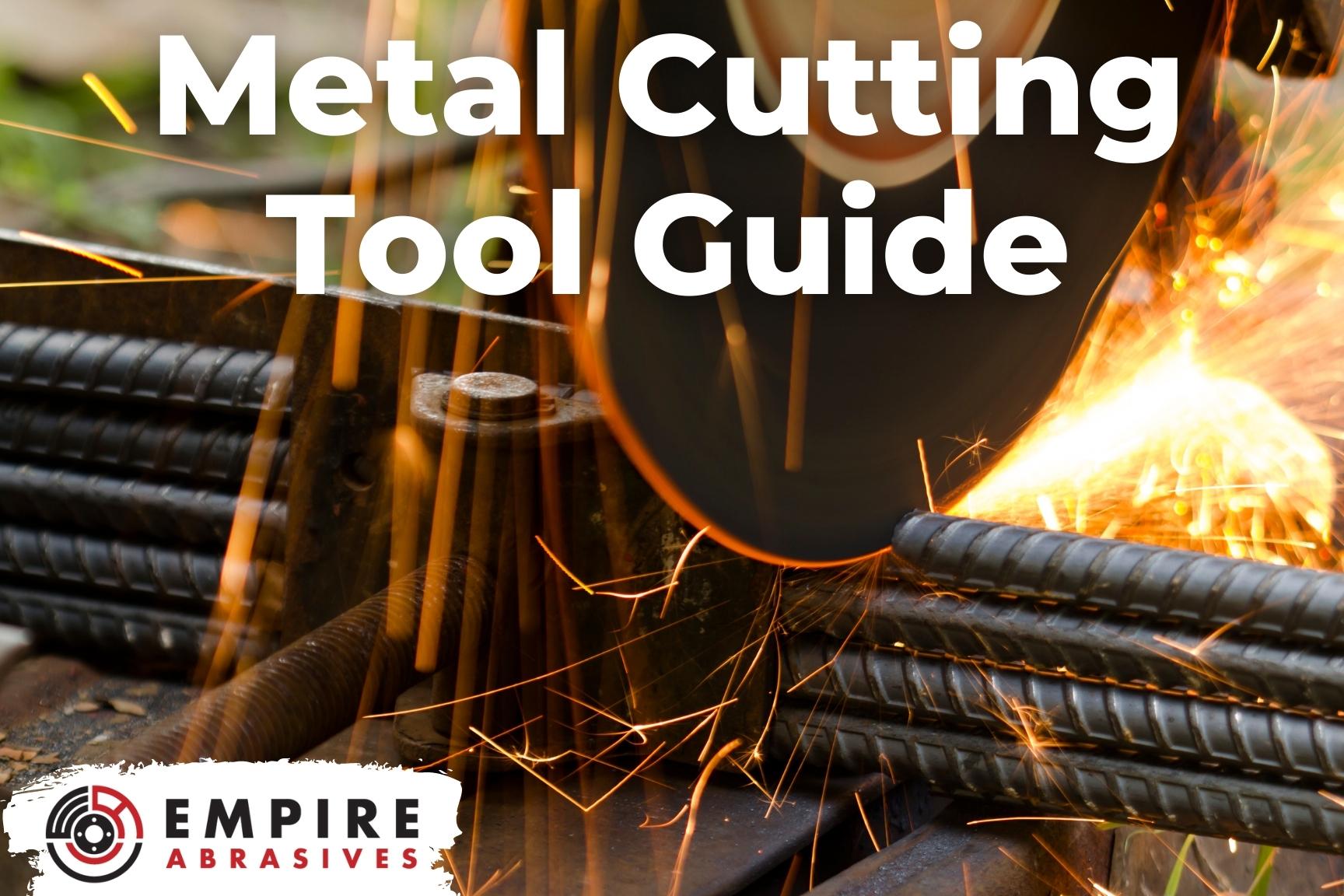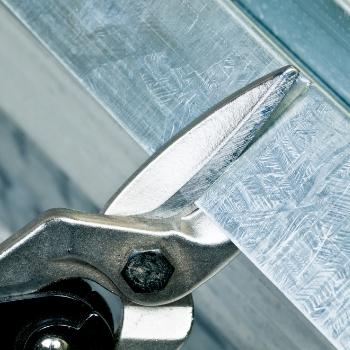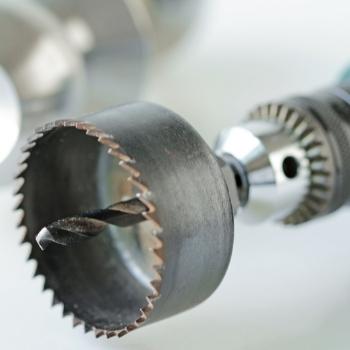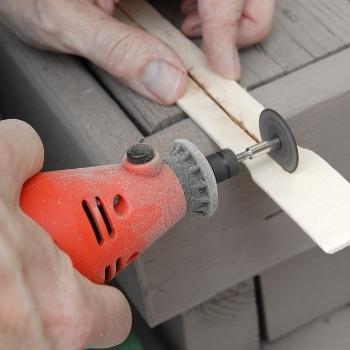
Metal may be the most versatile building material on earth, but turning raw materials into a polished final product requires skill and specialized tools. Metal is often challenging to work with, and each metal possesses unique properties and characteristics that require a variety of cutting tools to fabricate them.
Today, we’ll cover each of the different metal cutting tools and their uses, so you can be sure to reach for the right tool as you learn how to cut metal.
Hand Tools
There are various hand tools for cutting metal, and while they require more time and effort than a power tool, they can be equally helpful, especially for smaller projects. These are the hand tools you’ll commonly see in a metal shop.
Metal Snips

Metal snips are for cutting sheet metal, and they resemble a pair of scissors or shears. Sheet metal snips come in three varieties. The standard pair is made for making straight cuts, but it’s impossible to manipulate around curves. Other pairs have curved jaws that allow them to negotiate left or right-hand turns. You commonly purchase snips in sets of three for this reason.
These tools are best for making rough cuts in sheet metal and for working with thin materials. These snips can be challenging to keep straight while cutting, and the cut often has burrs or jagged edges throughout that require finishing later on.
Pros
- Ideal for soft sheet stock like tin, copper, or aluminum
- Inexpensive
- Can make cuts in tight areas
Cons
- Leaves a jagged, unfinished edge
- Can’t cut heavier stock
Hacksaw

A hacksaw is one of the most inexpensive and popular metal tools, and it’s useful for a variety of scenarios. These saws consist of a metal handle with a plastic or wooden grip and a replaceable metal cutting blade. Hacksaws can cut through a pipe, metal stock, and heavier gauge sheet metal, and they leave a relatively clean cut that’s easy to refine.
You’ll need a good bit of elbow grease when using a hacksaw, but for making straight cuts, they’re one of the most helpful metal cutting tools.
Pros
- Versatile - cuts through virtually all metals
- Blades are easy to replace
- Inexpensive
Cons
- Can only make straight cuts
- Time-consuming
Beverly Shear
The throat-less shear, better known as a Beverly shear, after the most popular manufacturer to produce them, is a powerful hand tool useful for cutting various clean-cut metal stock.
These tools usually consist of cast metal, and they have a fixed base that’s mounted to a workbench or the floor and a guillotine-like blade on a handle. As the handle is depressed, the blade cuts through the metal stock. Since these tools have a smaller cutting surface and no throat, they can easily navigate turns and straight cuts.
Pros
- Ideal for detail work and navigating tight turns
- Faster and easier than snips
- Produces a relatively clean edge
Cons
- Only works on sheet material
- Fairly expensive for a hand tool
- Not as portable as other hand tools for cutting metal
Power Tools
While hand tools certainly have their place in a metal shop, most fabrication occurs with power tools. These are the most commonly found power tools you’ll find in the shop to cut metal.
Angle Grinder

An angle grinder or hand grinder is perhaps the most indispensable of all metal cutting tools. These compact tools have a 4 ½” cut-off wheel, but they can be outfitted with different discs or accessories to serve various purposes.
Grinders can quickly work through various metals, including sheets, tube or bar stock, hardware, and much more. Grinders are best for unfinished metal, rough cuts, removing seized hardware, or cutting welds. The blade gets exceptionally hot during the cutting process, which can burn paint or finish off the piece you’re working on. For this reason, there are other tools better suited to finish work.
Pros
- Incredibly versatile
- Compact size allows you to work in tight places
- Compatible with a variety of blades and cutting surfaces
Cons
- Not ideal for fine details and finish cuts
- Wheels are easy to break if used improperly
Reciprocating Saw

A reciprocating saw (aka Sawzall) is one of the most popular and useful tools for demolition, and it’s effective for cutting metal, provided you use it for demo purposes. Reciprocating saws are among the most aggressive and powerful saws. Outfit a reciprocating saw with the proper reciprocating saw blades for metal, and it will be able to make quick work of everything from sheet goods to pipe to flat stock.
Bear in mind that a reciprocating saw is about as precise and delicate as a bull in a china shop, so you should only use it for demolition and rough cutting. While there are better tools for most jobs, there’s something to be said for how much fun it is to chop something up with a reciprocating saw.
Pros
- Cuts through virtually anything
- Powerful and fast
- Variety of blades for different cutting scenarios
Cons
- Very rough and imprecise
- Can damage wires or pipes easily with its long blade
Circular Saw

A circular saw is another popular woodworking tool that you can outfit with specialized blades for cutting metal. There are blades for cutting aluminum and abrasive cutting wheels that work well for cutting tubes or bar stock.
Some fabricators will install a standard circular saw blade backward for cutting sheet goods, but this is potentially dangerous and not recommended. Instead, a 7” abrasive blade for circular saw would be an ideal option.
Pros
- Does an excellent job with tube and bar stock
- Makes a clean cut through most metals
- Readily available
Cons
- Doesn’t work well for sheet goods
- Blades can break easily
Jig Saw

A commonly used tool in most woodshops, jigsaws can also help cut metal, provided the saw has a proper metal cutting blade. Jigsaws can be very useful for cutting tight curves and fine details in thin and medium-gauge sheet materials, but it isn’t handy for cutting other types of material.
Pros
- Inexpensive and commonly available
- Blades are replaceable
- Works well for tight turns and curves
Cons
- Only works well with thin sheet products
- Blades break often
Hole Saw

Hole saws are bits that attach to a drill or drill press for cutting circles. These hollow cylinder bits usually have fine teeth to cleanly cut through a variety of sheet materials. Bi-metal hole saws are preferred, as they offer the most versatility for cutting different metals.
Pros
- Cuts a perfect circle
- Inexpensive
Cons
- Not versatile
Cut-Off Tool
A cut-off tool is similar to an angle grinder but with smaller 3 inch cut off wheels, perpendicular to the handle. Cut-off tools are available in electric and pneumatic varieties, and they come with an abrasive cut off wheel that makes quick work of sheet goods, old bolts, fasteners, and tack welds.
A cut-off tool is handy in tight spaces where other tools can’t fit, but its small size makes it a poor choice for cutting through thicker materials.
Pros
- Compact and easy to maneuver
- Fits in tight spaces
- Ideal for removing welds and cutting stripped hardware
Cons
- Too small for larger applications
- Cutting wheels are fragile
Air Saw
An air saw is one of the most effective and precise instruments in a metal shop. An air compressor powers these saws, and they’re small, lightweight, and easy to manipulate. For curves and turns, an air saw is virtually unbeatable. These saws can also make straight cuts, but it takes some practice before you’re able to pull reliably straight lines.
Air saws work best with thinner metals, but they can reliably cut through thicker stock as well. The thicker the material, the longer it will take to cut, and the more blades you’ll burn through. Fabricators will often use an angle grinder for cutting heavier sections of metal, leaving the air saw for more precise finish work.
Pros
- Lightweight, versatile, and easy to maneuver
- Replacement blades are cheap
- No motor to worry about burning out
Cons
- Doesn’t work well with thicker materials
Rotary Tools

Rotary tools and die grinders, commonly known by their most popular manufacturer (Dremel), are precision tools that are very useful for fine detail work. These tools accept various cutting, grinding, or polishing bits, which attach to a collet at the bottom of the tool.
Rotary tools are versatile, and while you can use one with virtually any material, die grinders are made especially for cutting and grinding metal. Their compact size and full range of motion allow you to cut curves, straight lines, and fine details that are impossible with other tools.
Pros
- Different bits serve tons of applications
- Ideal for fine detail work and working with small parts
- Affordable
Cons
- Only useful for detail work
Chop Saw

A chop saw is a standard woodshop tool that can also be useful when working with tube or bar stock as it can make straight cuts with ease when you replace the blade with an abrasive cutting wheel.
Chop saw blades can cut through thicker materials with relative ease, and the saw leaves a reasonably clean edge.
Pros
- Excellent for cutting thicker materials, especially tubes, pipes, or flat stock
- Virtually any chop saw can be outfitted with a cutting wheel to use for metal
Cons
- Tons of sparks during the cutting process
- Cuts aren’t very square
Cold Saw
A cold saw is essentially a chop saw made specifically for cutting metal. These saws have a fine-tooth blade and a pneumatic system that constantly feeds cold water onto the saw blade. These saws don’t generate sparks, and they can make very clean and straight cuts in thick material in a matter of seconds.
Pros
- One of the fastest and most efficient ways to cut thick material
- No sparks in the workshop
Cons
- Highly specialized
- Expensive
Oxy-Acetylene Torch

An oxy-acetylene or cutting torch is a powerful tool that can easily cut virtually any metal, regardless of thickness. These are those torches you often see in movies when bank robbers are trying to break into a vault. Compressed gas tanks of oxygen and acetylene fuel these torches. You dial in the proper ratio of these two gases to create a scorching hot and focused flame that can cut through any material with ease.
A cutting torch is ideal for cutting through heavy stock materials, steel bars, beams, and other building materials. For thinner materials or painted surfaces, the flame from the torch will burn and warp them.
Pros
- Ideal way to cut heavy materials
- Tool can also be used for welding
Cons
- Tanks take up lots of space
- Not useful for thinner materials
Plasma Cutter

The mack-daddy of all cutting tools, plasma cutters are pretty similar to oxy-acetylene torches, but they offer a few benefits. These tools aren’t as hot as a cutting torch, so you can use them with thinner materials and heavier ones. With a steady hand, you can cut virtually any shape, line, or curve using a plasma cutter.
Plasma cutters are available as a handheld tool, but the technology is often used as part of larger CNC machining setups.
Pros
- Safer than a cutting torch
- Ideal for cutting custom shapes
- Compact and portable
Cons
- Expensive
- Requires some clean up around the cut
Still Have Questions?
If you have a metal cutting job coming up and you still need some help, please feel free to contact us via phone, email, or chat to discuss your options. Let us know the type of metal you’re trying to cut and which tools you have on hand so we can help you make the best choice.
